Jonelle Patrick's Blog, page 77
May 13, 2013
Hey Look, It’s L o’ Clock!
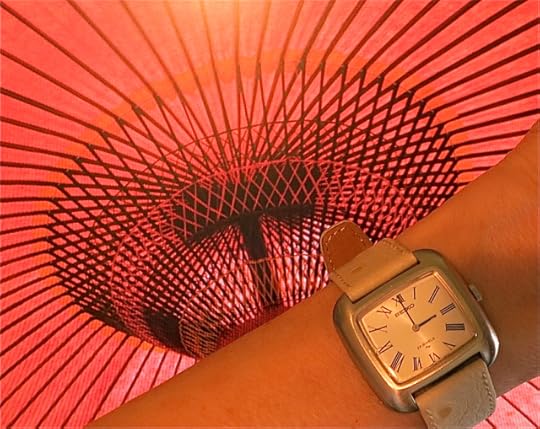
And how lovely it is, displayed on my vintage restored Seiko!
It’s L o’clock, and that means it’s time to check out an old art that’s alive and well in Tokyo: watchmaking!
Actually, although I’d like you to believe I discover these things on purpose, the battery in my watch died and I was desperate to get it fixed. I’d met Akiyama-san at a year-end drinkfest, and I asked him if he did mundane things like that. Of course, he said, bring it in! So I did. And I discovered a fascinating kind of shop that you don’t often see in America anymore. In Japan, despite the fact that it’s one of the wealthiest societies in the world, people still try to repair things before throwing them away. Even cheap watches get repaired instead of tossed. (If you’ve ever seen the garbage regulations, you’ll understand why!)
And lest you think this is a dying craft practiced by wizened Gepetto look-alikes, let me assure you that so many people repair their watches instead of buying new ones, even young and handsome guys believe there’s a future for them in watchmaking!
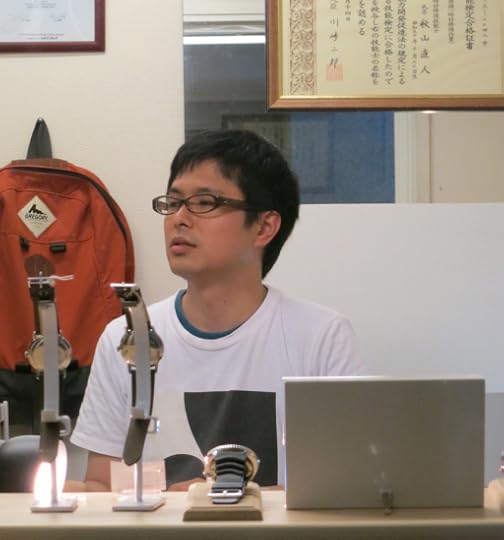
Akiyama-san, in his shop, not resembling a grizzled watchmaker of yore.
He fixed my battery in no time flat, then I stayed to watch as Akiyama-san practiced the arcane art of putting a vintage watch back together. Wearing a jeweler’s loupe, he wielded tiny specialized tools to position each piece on a special mount, then started it up and adjusted it with an electronic timer before settling the works back in its case.
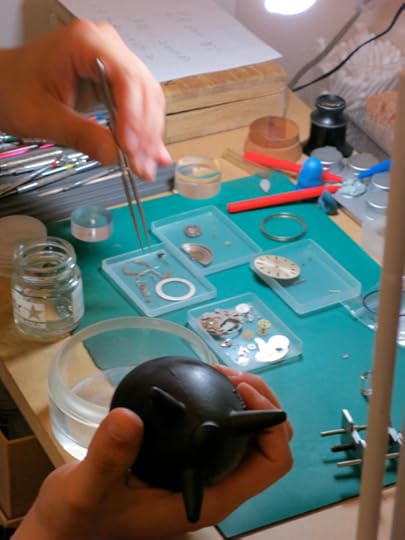
If you don’t have patience and a steady hand, do not apply!

Before visiting Akiyama-san’s shop, I never thought about the beauty that resides inside the thing on my wrist.
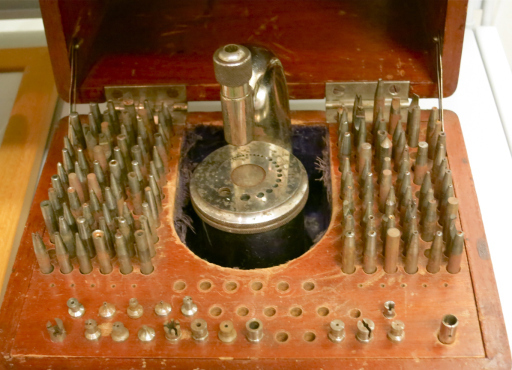
Tools from a bygone era, still used every day.
But although Akiyama-san will repair any watch that walks through the door, his real passion is restoring vintage watches and selling them. Check out these beauties!
 If you’d like to visit Akiyama-san’s shop the next time you’re in Tokyo, get off the Keio Line train at Gotokuji Station, turn right at the ticket gate and walk down the street lined with shops. About a block away on your left, you’ll spot a sign out on the sidewalk that says “L o’Clock.” turn left into the passageway and it’ll be ahead on your right. Or visit his L o’ Clock website to see what gems he’s got in stock. Open noon – 8:00 p.m., closed Thursdays, map here.
If you’d like to visit Akiyama-san’s shop the next time you’re in Tokyo, get off the Keio Line train at Gotokuji Station, turn right at the ticket gate and walk down the street lined with shops. About a block away on your left, you’ll spot a sign out on the sidewalk that says “L o’Clock.” turn left into the passageway and it’ll be ahead on your right. Or visit his L o’ Clock website to see what gems he’s got in stock. Open noon – 8:00 p.m., closed Thursdays, map here.


May 12, 2013
Engrish Menu Item Of The Day
Yes, even I had to stop and puzzle over this one for a minute before figuring out the chop sui lunch at this Nishi Azabu Chinese joint was flavored with soy sauce! At least someone caught the “rice” typo, or I’d have been really confused…


May 11, 2013
A Day In The Life: What’s It Like To Be A Host?

“My name is Sakura, and this is our newest host, Yua. If you join us tonight, you can see what a new host does!”
Fallen Angel readers are asking what it’s really like to go to a host club, so in addition to my usual daily Japan blurbs, I’ve been writing a series of blog posts on the Top Ten Host Club Questions. The final question is:
So what’s it like to be a host? A day in the life…
Join veteran host Sakura-san as he teaches his new recruit “Yua-kun” the ropes! First, a run-down of a typical day in Yua’s life:
11:00 a.m.: Wake up*
Noon: Go to the hair salon to get his tresses waxed, teased, arranged and sprayed.
1:00 p.m.: Go home and relax until it’s time to go to work
4:00 p.m.: Leave for work.
4:05 p.m.: Arrive at work. Do various chores before opening the club, then support Sakura-san entertaining clients until midnight.
12:00 a.m.: Every day is different, but even though 12:00 is “closing time,” the door may not swing shut behind the last customer until 1:00.
1:00 a.m.: Talk with co-workers at the after-hours staff meeting.
1:30 a.m.: Go out to eat and drink with co-workers
5:00 a.m.: Go home and sleep.
* You may have noticed that the a.m. and p.m. hours are switched on the Japanese schedule in the box above. That’s because hosts live a life that is 12 hours ahead of day workers, and they say, “Good morning!” to their co-workers at 7:00 p.m.rather than 7:00 a.m.
Okay, let’s see what happens during the hours Yua is at the club:

Yua (to his mentor and other hosts): Good morning! (even though the sun already went down.)
Yua starts his workday doing the scut work: wiping down the tables until they gleam to the manager’s satisfaction, setting up the first customer’s glasses, ice bucket, tongs and ashtray, and doing even less glamorous things like cleaning the toilets. His mentor advises him that even though these jobs are not exciting, if he does a good job, he’ll prove himself to the manager as a hard worker and will graduate to being a top-earning entertainer faster.
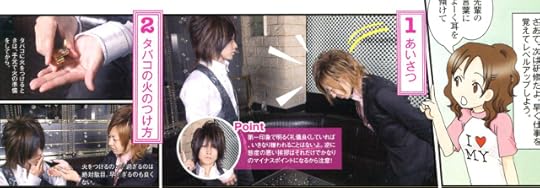
Our customer-angel admonishes Yua to listen to his mentor and follow his advice, so he can “level up” as soon as possible.
Okay, it’s almost time for the club to open! Before the first customer arrives, Yua must do a proper “aisatsu” to his mentor, bowing respectfully and asking Sakura-san to do him the great favor of teaching him the proper way to become a good host. If Yua diligently does everything Sakura asks him to do and thanks him properly for teaching him (even when Sakura scolds him for making a mistake), Sakura will return the favor by introducing him to his customers and helping him build a customer base of his own. Today Sakura will teach Yua how to light a customer’s cigarette. Sakura shows Yua how to flick his lighter to life, cupping it in his hand near himself so as not to endanger the customer, then light the end of her smoke with a graceful gesture.

Tonight’s additional lesson before the club opens: How to pour a drink. First, use the tongs to place ice in the glass deftly and silently, trying not to rattle the cubes or tongs against the side. Then rest a pinky finger on the table and – using that hand for support – rest the bottle label-side up on the hand and tip liquor into the glass, pouring in the sho-chu without letting the bottle clink against the rim. Top the glass up with water, using the same pouring technique. Then use one hand to shield the customer from splashes and deftly stir the drink, without making any noise. Still shielding the customer, let the stirrer drip into the glass, then use it to make your own drink. Place the stirrer back on the napkin on the tray, then offer the customer’s drink to her respectfully with both hands. With your own drink, propose a toast, making sure that when you clink your glass with hers, you do it respectfully with both hands and take care to make sure it’s in the lower position.
Finally, opening time! Tonight Yua is lucky – he’s not being sent out to the nearby street to do “catching” duty, inviting girls into the club. Sakura introduces Yua to his first customer, and the new host practices what he just learned, taking care of the customer and his mentor with proper respect. He does his share of keeping a lively conversation humming along, then thanks Sakura’s customer for letting him intrude on their evening, proposes a toast to both of them, then gracefully exits to give them some time alone.
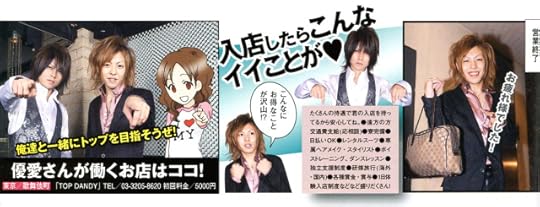
The club is busy, and 1:00 comes all too soon. “Good work tonight! Job well done!”
We’re left with the parting message that good-looking guys who think this might be the ideal job for them should know that the mentors at the sponsoring club (Top Dandy) will not only train them to become top-earning hosts in no time, the club also offers snazzy designer suits for rent until the nouveau host can afford his own, the job is flexible and hosts can get their pay at the end of every workday, they can make use of the hair-make stylist who comes to the club every day before it opens, the club will pay for singing and dancing lessons, the club will pay for all the hosts to go on vacation together (sometimes to foreign countries!), and if they make it into the top five earners, they’ll really level up to the big money, with bonuses on top of their salaries and a percentage of their dedicated customers’ bar tabs.
The TOP TEN QUESTIONS ABOUT HOST CLUBS series:
Why do women go to host clubs?
What kind of women go to host clubs?
What’s it like to visit a host club?
How expensive is it to go to a host club?
What is a host club “champagne call”?
Can foreigners get into a host club?
How do I find a good host club?
Why Do Hosts Dress Like That? Everything You Always Wanted To Know About Host Fashion
Photo essay courtesy of Men’s Yukai magazine.
***
I first started researching the world of host clubs while I was writing Fallen Angel , the second book in my Japanese mystery series. If you want an insider’s look at host club life, you won’t get much closer than seeing it through the eyes of Hoshi and Shinya, the hosts who work at Club Nova. They may be guilty of stealing their customers’ hearts, but are they guilty of murder?…


It’s Raining Schoolkids!

Teachers, don’t you wish you were riding the subways in a distant city with sixty 12-year-olds RIGHT NOW?
Yessiree, right now, every train station and airport is thronged with flocks of schoolkids, going on class trips to distant educational hot spots! Peak season for these multi-day Educational Experiences (or My Week In Hell, if you’re one of the two teachers herding thirty 15-year-olds 24/7) is late spring, so everywhere you go, you see vast crowds of 6th graders, 9th graders and 12th graders.
The kids tour together, eat together, sleep together and most hair-raisingly, ride public transportation together for three days and two nights. And if the teachers were very, very bad in a former life, rainy season will blow in early, and a wicked storm will shut down all train service for a few days, stranding them and their restive charges beside the bullet train tracks for DAYS. (This is a favorite staple of Japanese TV storm coverage. Feel the horror.)

Persons easily lost in cities far from home must wear identifying hats.


May 10, 2013
Lurking Foreign Mannequins
What’s that suspicious foreign mannequin doing, slouching around behind the trashcans in this Kappabashi store? You can tell by his mustache he’s up to no good.
And what about the scarily cheerful auntie behind the counter at the kitchenware store? Escaped from the loonie bin halfway house, no doubt.


May 7, 2013
Real Live Tanuki Sighting!
Ahahaha, I bet you thought tanukis were the stuff of Japanese legends – crafty tricksters with notoriously large cojones who play pranks on gullible humans – but it turns out tanuki are alive and well and living on some of the choicest real estate in Tokyo!
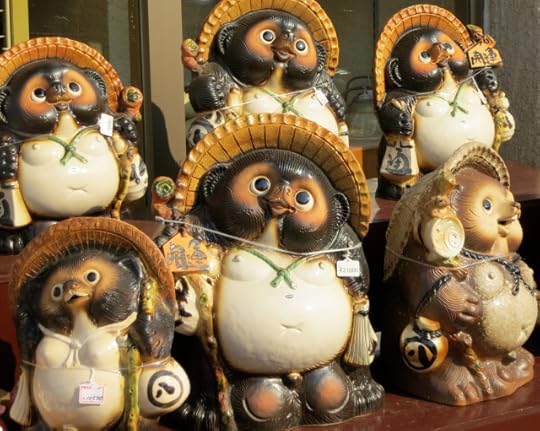
This is the most common type of tanuki sighted in Japan – he (and his legendary 8-tatami-mat size you-know-whats) are usually spotted in urban habitats. The tend to live outside restaurants and shops, put to work 9-5 bringing in the business.

So imagine my surprise when I saw this furry fellow without his customary sake bottle, and no restaurant in sight!
I saw this little guy at the Meiji Shrine’s Nai-en Garden this week. He was about as big as a fox and was just hunkered down in the leaves near a main path with a front row seat for viewing the strange animals that had gathered in a chattering mob to take its picture. It got up and ambled over for a closer look before wandering back to its lair to post a “saw a whole herd of them today” on tanuki Facebook.
So, I got curious about them, and like so many things in Japan, truth is stranger than fiction! They are canids, but they can climb trees! They can eat poisonous toads! They hibernate in winter (although some only hibernate during mega-snowstorms)! Real ones, however, can’t turn into magic teakettles.

“Guess I’ll head back to my lair and Tweet about the exotic animals I saw today at the shrine garden…”
If you’d like to visit the Meiji Shrine and the Nai-en garden next time you’re in Tokyo, pictures and directions are on my website, The Tokyo Guide I Wish I’d Had . I can’t guarantee you’ll see a tanuki, but it’s well worth a visit anyway, because not only is the place gorgeous, you might see a Japanese wedding, women and children wearing beautiful kimonos, or free demonstrations of traditional Japanese music, dance, or archery.


A Real Live Tanuki!
Ahahaha, I bet you thought tanukis were the stuff of Japanese legends – crafty tricksters with notoriously large cojones who play pranks on gullible humans – but it turns out tanuki are alive and well and living on some of the choicest real estate in Tokyo!

This is the most common type of tanuki sighted in Japan – he (and his legendary 8-tatami-mat size you-know-whats) are usually spotted in urban habitats. The tend to live outside restaurants and shops, put to work 9-5 bringing in the business.

So imagine my surprise when I saw this furry fellow without his customary sake bottle, and no restaurant in sight!
I saw this little guy at the Meiji Shrine’s Nai-en Garden this week. He was about as big as a fox and was just hunkered down in the leaves near a main path with a front row seat for viewing the strange animals that had gathered in a chattering mob to take its picture. It got up and ambled over for a closer look before wandering back to its lair to post a “saw a whole herd of them today” on tanuki Facebook.
So, I got curious about them, and like so many things in Japan, truth is stranger than fiction! They are canids, but they can climb trees! They can eat poisonous toads! They hibernate in winter (although some only hibernate during mega-snowstorms)! Real ones, however, can’t turn into magic teakettles.

“Guess I’ll head back to my lair and Tweet about the exotic animals I saw today at the shrine garden…”
If you’d like to visit the Meiji Shrine and the Nai-en garden next time you’re in Tokyo, pictures and directions are on my website, The Tokyo Guide I Wish I’d Had . I can’t guarantee you’ll see a tanuki, but it’s well worth a visit anyway, because not only is the place gorgeous, you might see a Japanese wedding, women and children wearing beautiful kimonos, or free demonstrations of traditional Japanese music, dance, or archery.


May 6, 2013
Beer Terminal!
Recently my train line – the Toyoko-sen – was tragically re-routed through Shibuya station to make way for five long years of renovation on the circling-the-drain Tokyu Department Store. The transfer from the Toyoko line to any other remotely useful train line has become so arduous, I wouldn’t be surprised if it inspired a game company to build a “Commuter Quest” RPG as a result. But right now, if the weary pilgrim manages to make it as far as the old terminus, there’s a ray of hope! The Beer Terminal!
Yes, some enterprising outfit has managed to set up a watering hole of epic proportions right on Platform 4! And judging by the line – which had reached Disneyland-like proportions by 5:30 on the day I was there – it’s such a success they ought to consider doing away with the idea of rebuilding the department store altogether and just put in a record number of taps instead.


May 4, 2013
Swimming In The Sky
I love these. Every year on May 5, families fly koi nobori outside their houses as a sort of prayer that their sons will become like the carp that climbed the waterfall to become a dragon. These fish flags always cheer me up, but this year for some reason the public displays are particularly exuberant!
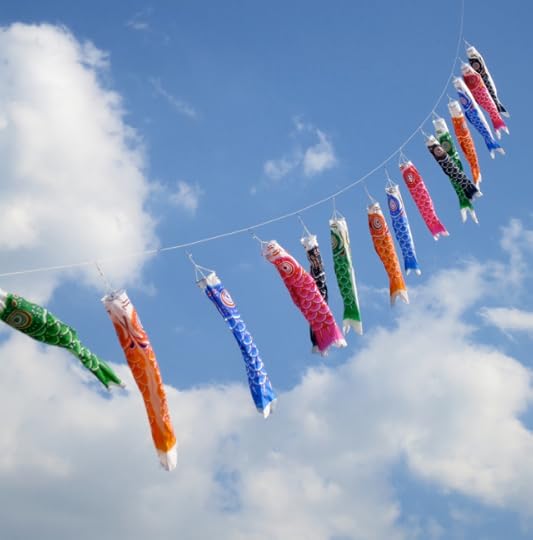
A man at Yoyogi Park was flying a kite with koi nobori hanging from the string!
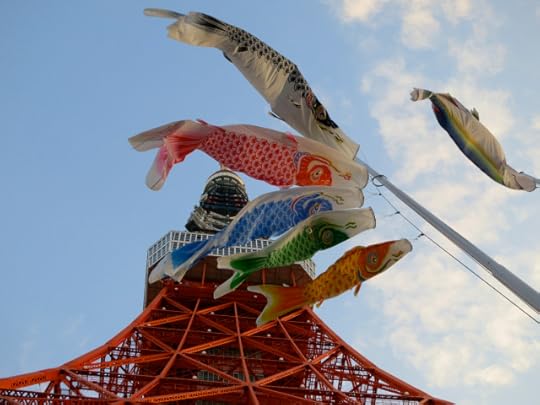
These were flying outside Tokyo Tower (I’m telling you in case you missed the orange, larger-than-life, Eiffel replica in the background).

“Koi nobori” = climbing carp. Literally!
May 3, 2013
Stuff Nobody Knows About The 47 Rōnin!
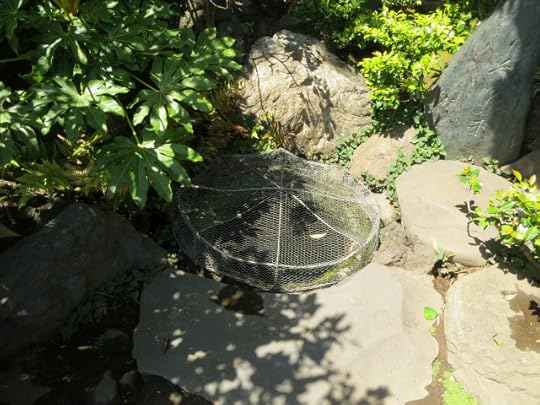
If you’ve got a severed head to wash, this is the place to do it.
In case you don’t live in Japan or were raised by wolves in rural Aomori, the story of the 47 rōnin goes like this: After being insulted in the castle of the shōgun, Lord Asano draws his sword and wounds his tormentor, Lord Kira. Asano is sentenced to commit ritual suicide for committing this unpardonable offense. His 47 loyal samurai plot for two years, and finally avenge him, cutting off Lord Kira’s head and marching it to Sengakuji Temple, where they offer it at Lord Asano’s tomb. Then they give themselves up at the castle and are given the sentence they know they will receive: death by seppuku, just like their lord.
But whoa, there’s a lot more to the story, and I learned it when I went to Sengakuji temple this week to visit their graves and prowl around the museum! For example:
What kind of wacko leader would make pulling out your sword indoors a death penalty crime?
Well, first of all, swinging around the kind of sword that can cut through multiple condemned criminals’ bodies with a single stroke* is no joke, and Lord Asano actually wounded Lord Kira on the face before being stopped by the guy Kira had been chatting with in the hallway. Apparently, Kira enraged Asano by calling him some kind of bridge and tunnel wannabe, but Asano should have sucked it up because Kira was Asano’s boss, a much higher-ranking official who was in charge of making sure protocol was followed by the imperial delegation from Kyoto that was in town for a summit meeting with the shōgun. So it wasn’t just that Asano drew his sword in the castle (forbidden), he also used it to attack his superior (not done in polite company) at a time when Lord Kira was just having a little natter in the hallway (bad form) while not only the shōgun, but also the emperor’s ambassadors were nearby, about to have a summit meeting in the rooms beyond (really, really, bad timing). When you consider the circumstances, the sentence seems a little less outrageous.
So what was it that pissed off Asano’s 47 employees so thoroughly that they were willing to get the death penalty themselves just to experience that “ah, sweet revenge!” moment?
Well, first of all, everyone agrees the shōgun acted a little hastily. After the Imperial summit meeting was abruptly shuffled off to another wing of the castle, without any investigation, the shōgun sentenced Lord Asano to commit ritual suicide on the very same day the attack occurred. What’s worse, he was so T-ed off, he made Asano to do it outside (in a garden, which was hell on the plantings and not exactly the kind of thing you want to remember while strolling through the plum blossoms every year). Being killed outside was the punishment for convicted felons, not lords of the realm, a huge disgrace for him and everyone associated with him.
But serious life-threatening embarrassment aside, there were other wretched consequences for those still in the land of the living. Lord Asano’s family was abruptly booted from the aristocracy, their lands and income confiscated. That meant that not only was everyone in Asano’s family suddenly in the breadline, the samurai who served him (along with the countless retainers and servants and all their families) were all out of a job. And I mean REALLY out of a job: no severance, no accrued vacation days, no letter of recommendation, nothing. Who’s going to hire a disgraced samurai whose sworn loyalty is to another lord?
How exactly did they manage to cut off Lord Kira’s head?
It wasn’t easy! You didn’t get to be a 62-year-old warlord in medieval Japan without being a tough and wily old dude. Kira knew Asano’s samurai had nothing left to lose, so he holed up in his castle accordingly, with all the defenses he could muster around him. But Oishi Kuranosuke (the leader of the 47 rōnin) was gifted with uber-craftiness.
It’s well known that Oishi made every one of the 47 melt into the hoi polloi, becoming carpenters and fishermen and practicing trades so far below their rank that they became invisible. Oishi himself appeared to become a public drunkard and frequenter of the pleasure quarters. So by two years later, with no sign of revenge in sight, Kira began to relax, believing that if they hadn’t attacked him yet, they weren’t going to.
The 47 stormed the castle one night and battled through all the guards, but Kira was nowhere to be found. Finally, they discovered a hidden courtyard where there was a closet used to store firewood and such. When they opened the door, a rain of rice bowls, charcoal, and all kinds of other crap began pelting them as Kira’s master swordsman leapt out and started slashing away. They managed to subdue him and the guy who was lobbing the kitchenware. The closet looked empty, but of course, that was an illusion. The suspicious rōnin rooted around and discovered an old man in white pajamas with a short sword. He refused to say who he was. (Most of the samurai hadn’t seen Lord Kira face to face – he was too high up – so at first there was an ID problem and they had to rely on the forehead scar that Lord Asano had given him on the fateful day.) They marched him over to the main courtyard and suggested he take the honorable way out, offering him the very same dagger Asano had used to commit ritual suicide, but he refused. Finally, they had to hold him down and whack, whack, Bob’s your uncle.
Stranger than fiction, right? But if you have any doubt at all that this story is true, check out the evidence at the Senkajuji temple museum!

The actual confession, signed by all 47 rōnin!

Because it’s Japan, if someone shows up delivering the lord of the manor’s severed head, you have to give them a receipt.
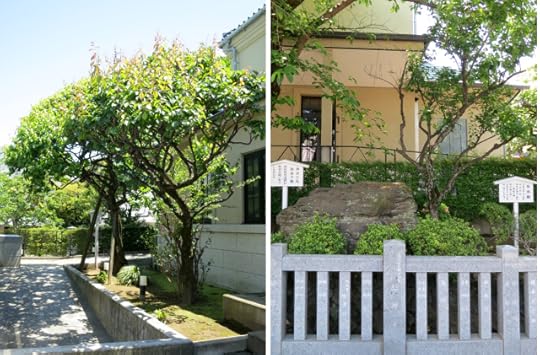
Various bloodspattered plum trees were transplanted to the temple. The first one on the left was the recipient of some good red stuff when the leader’s 16 year old son (the youngest of the 47) committed seppuku. The tree and rock on the right were watered by the blood of the leader himself.
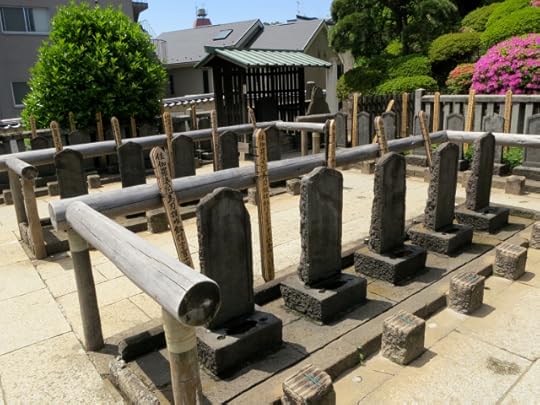
If you had any question about how highly revered these guys became, check out the fact that every grave has fresh sutra sticks behind it, faithfully donated by family members and admirers, even though these guys died back in 1703!
* I discovered this grisly way of rating the sharpness of swords while researching Fallen Angel, the second book in my Japanese mystery series!
Additional note: when someone commits ritual suicide, they are expected to poke the dagger in themselves, but they also have their most trusted swordsman friend standing by to lop off their head with a very sharp sword so they don’t hesitate. This person is called a kaishakunin, and if you’ve read Nightshade, you’ll know exactly what I’m talking about!













